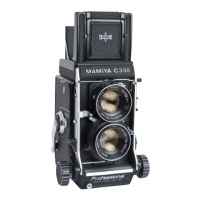
Do you have a question about the Mamiya C330S and is the answer not in the manual?
| Type | Twin-lens reflex camera |
|---|---|
| Film Format | 120/220 roll film |
| Image Size | 6x6 cm |
| Lens Mount | Mamiya C mount |
| Shutter Speed | 1 s to 1/500 s |
| Focusing | Bellows focusing |
| Metering | None (separate light meter required) |
| Viewfinder | Waist-level finder |
| Flash Sync | X sync at all speeds |
| Weight | 1800g |
Type: 6 x 6 Twin-Lens Reflex Camera with Interchangeable Lens System, Picture Size: 56 x 56 mm (actual picture area).
Lens (standard): Mamiya/Sekor 80 mm f/2.8, Shutter: Seiko-#0 (B, 1-1/500 sec., M-X synchronization).
Focusing: Front extension system by rack-and-pinion. Focusing screen: Changeable. Focusing hood: One-touch operation facilitates interchange of dioptric lenses.
Identification of primary camera body components like lens clamp bracket, synchro socket, shutter controls, and focusing knobs.
Identification of rear cover lock button, spool change knobs, film chamber, focusing screen frame lock, and film pressure plate.
Procedure for detaching a lens from the camera body by operating the lens lock knob and clamp bracket.
Procedure for mounting a lens onto the camera body, ensuring proper connection of cocking levers.
Key warnings regarding film advance crank position, lens lock knob, and shutter blade protection.
How to engage the magnifier by pushing the sportsfinder flap for precise focusing.
Pre-loading checks for lens lock knob (LOCK position) and shutter release lock (backward).
Steps to wind film advance crank, set shutter speed/aperture, and depress the shutter button.
Steps for inserting the take-up spool and the film roll into the film chamber.
Inserting leader paper into take-up spool and winding until the start mark aligns with camera marks.
Winding the film advance crank until it stops diagonally upward, readying the camera for the first exposure.
Adjusting shutter speed and aperture, then pressing the shutter release button or using a cable release.
Adjusting the parallax correcting dial to the lens's focal length for close-up focus and exposure factors.
Understanding parallax indicators on the screen and using a tripod device for accurate framing.
Using the distance scale ring and aperture setting to read the depth-of-field on the lens.
Situations preventing shutter release, such as unlocked lens, shutter lock, or film not loaded.
Addressing issues with non-cocked shutters and the effect of the multiple exposure dial on shutter release.
Table showing depth of field for the 55mm f/4.5 lens at various apertures and distances in feet.
Table showing depth of field for the 65mm f/3.5 lens at various apertures and distances in feet.
Table showing depth of field for the 80mm f/2.8 lens at various apertures and distances in feet.
Table showing depth of field for the 105mm f/3.5DS lens at various apertures and distances in feet.
Table showing depth of field for the 135mm f/4.5 lens at various apertures and distances in feet.
Table showing depth of field for the Super 180mm f/4.5 lens at various apertures and distances in feet.
Table showing depth of field for the 250mm f/6.3 lens at various apertures and distances in feet.
